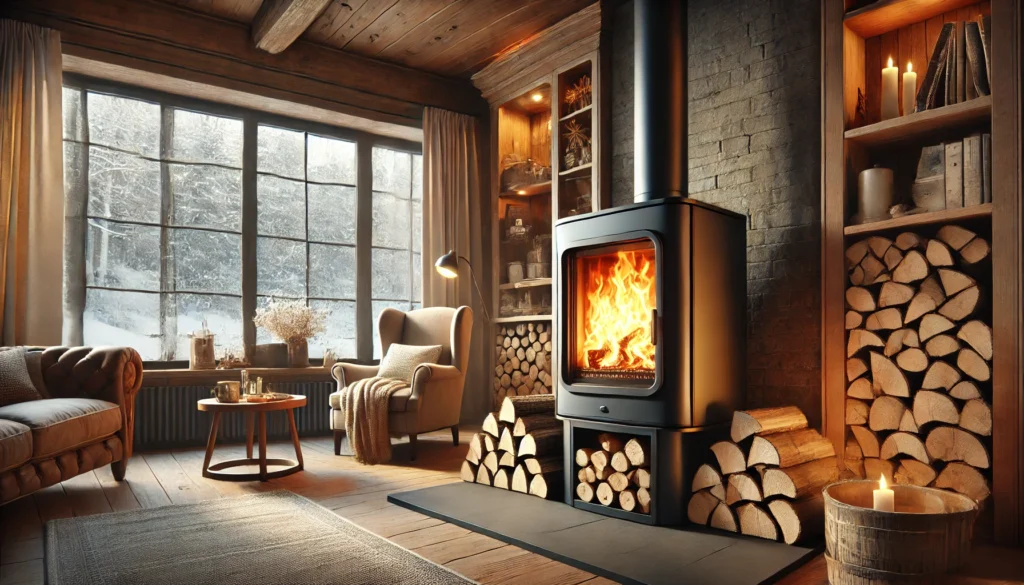What Are Wood-Burning Stoves?
In the quest for the perfect home heating solution, wood-burning stoves stand out for their unique blend of functionality and ambiance. These stoves not only warm your space but also transform it into a cozy, inviting haven. For those who enjoy the ritual of preparing and burning firewood, a wood-burning stove is more than just a heating system—it’s a lifestyle choice.
Listen to our Podcast
But how do wood stoves stack up against gas stoves, electric heaters, and pellet stoves in terms of efficiency, cost, sustainability, and overall experience? Let’s dive into a detailed comparison to help you make the best decision for your home and needs.

The Different Heating Systems You Can Choose From
- Wood-Burning Stoves
- Gas Stoves
- Electric Heaters
- Pellet Stoves
- Heat Pumps
Each of these options offers distinct advantages and disadvantages. Your choice will depend on your priorities—cost, convenience, sustainability, or a combination of these factors.
Why Choose a Wood-Burning Stove?
1. Efficiency and Costs
Efficiency and cost are paramount. Modern, EPA-certified wood stoves can achieve efficiencies of up to 85% (as per the latest EPA standards updated in 2022), ensuring more heat for your home and less waste. For rural residents with access to their own wood supply, this can be an incredibly cost-effective option.
In contrast, gas prices have seen significant volatility, with winter spikes common in many regions. Electric heating costs are also notably higher, especially for larger spaces, with the U.S. Energy Information Administration (EIA) highlighting electricity as one of the more expensive heating options.
Real-life Example (2023 Pricing): For a 2,500 sq. ft. home, a wood stove might cost approximately $2,200 for the unit and around $800 for installation, totaling $3,000 upfront. Seasonal heating with wood could cost between $400-$600, assuming a well-insulated home. In comparison, a gas furnace could cost around $3,500 upfront, with yearly gas costs potentially exceeding $1,500, depending on local gas rates and usage.
2. The Ambiance
Beyond heating, wood stoves offer an unparalleled ambiance. The sensory experience of a crackling fire, the warmth, and the aesthetic appeal are unmatched by other heating systems.
Use Case: Imagine returning from a snowy day to the immediate warmth and comforting glow of your stove. The experience becomes an integral part of your home’s character, offering a sense of comfort and well-being that’s hard to quantify.
Smart Home Integration: With the rise of smart homes, some wood-burning stoves now integrate with smart thermostats and home automation systems, allowing for remote monitoring and optimization of your heating, further enhancing efficiency and convenience.
Gas Stoves: Convenience, But at What Cost?
1. Convenience
For those valuing ease of use, gas stoves are hard to beat. They offer instant heat with minimal effort—no logs to split, no ashes to clean. However, this convenience comes with higher operational costs and a greater environmental impact due to greenhouse gas emissions.
2. Installation and Maintenance
While gas stove installation mainly involves connecting to existing gas lines (with costs ranging from $500 to $2,000, depending on the setup), annual inspections are crucial for safety and efficiency. This adds to the overall cost of ownership.
Maintenance Example: Annual gas furnace inspections can cost between $100 to $300, ensuring your system operates safely and efficiently. In contrast, wood-burning stoves require more frequent cleaning but less frequent professional service.
Electric Heaters: Simple but Costly
1. High Running Costs
Electric heating systems are straightforward to install but costly to run, especially for larger spaces. With electricity costs varying significantly by region, heating a home with electricity can lead to substantial bills, especially during colder months.
Cost Breakdown (Estimates): Heating a 2,500 sq. ft. home with electric heat could cost upwards of $450-$600 per month, depending on your local electricity rates. This contrasts sharply with the yearly costs of wood-burning stoves.
2. Limited Efficiency
While electric heaters are efficient in converting electricity to heat, they lack the heat retention of wood stoves. Once turned off, the room cools down quickly, whereas a wood stove continues to radiate warmth.
Pellet Stoves: Automation Meets Sustainability
1. Pellet Stoves vs. Wood Stoves
Pellet stoves combine the automated convenience of gas heaters with the sustainability of burning wood-based fuel (compressed wood pellets). They offer higher efficiency (up to 90% in newer models) and less manual labor, but require regular pellet refills and periodic cleaning.
2. Environmental Benefits
Pellet stoves have a slight environmental edge. Since pellets are made from waste wood products, they’re considered a more sustainable heating option. However, the production and transportation of pellets contribute to their overall carbon footprint.
Carbon Neutrality: Recent studies suggest that when the entire lifecycle (production to end-use) is considered, pellet stoves can achieve carbon neutrality, especially if the electricity used in pellet production comes from renewable sources.
Heat Pumps: The New Efficiency Standard
1. Efficiency and Cost Savings
Heat pumps are increasingly recognized for their efficiency, capable of providing up to 4 units of energy for every unit of electricity used. This translates to significant cost savings, especially in well-insulated homes.
2. Sustainability
Operating on electricity, heat pumps are as green as your power source. With the global shift towards renewable energy, heat pumps are emerging as a highly sustainable heating solution.
Use Case: For new constructions or homes undergoing major renovations, integrating heat pumps with underfloor heating or radiant panel systems can offer unparalleled comfort and efficiency.
Environmental Impact: Which Heating System is Greener in 2023?
1. Wood-Burning Stoves
Sustainably sourced wood is carbon-neutral. However, the overall environmental impact depends on the stove’s efficiency and the wood’s moisture content. EPA-certified stoves and well-seasoned wood are key to minimizing emissions.
2. Gas Stoves and Electric Heaters
Gas stoves emit fewer particulates but more CO2 than wood stoves. Electric heaters are only as clean as the electricity generating them. As the grid becomes greener, so does electric heating.
3. Pellet Stoves
Pellet stoves balance sustainability with automation. While not perfect due to production and transportation emissions, they’re a solid choice for those seeking a more eco-friendly option without the manual labor of wood stoves.
4. Heat Pumps
Heat pumps are the greenest option when powered by renewable electricity, offering a pathway to zero-carbon heating.
Installation Considerations
1. Wood-Burning Stove Installation
- Cost: $500-$1,500
- Considerations: Chimney/venting system requirements, existing setup utilization.
2. Gas Stove Installation
- Cost: $500-$2,000
- Considerations: Gas line setup or connection, ensuring safety and efficiency.
3. Electric Heater Installation
- Cost: Negligible (plug-and-play)
- Considerations: Outlet availability, potential for whole-house heating limitations.
4. Pellet Stove Installation
- Cost: $1,000-$3,000
- Considerations: Venting requirements, pellet storage space.
5. Heat Pump Installation
- Cost: $2,000-$5,000
- Considerations: System compatibility with your home’s insulation and heating needs, outdoor unit placement.
FAQs
Q: How do wood-burning stoves compare to pellet stoves in terms of maintenance?
A: Wood-burning stoves require regular ash removal and chimney cleaning. Pellet stoves need less frequent but still regular maintenance, including pellet hopper refills and cleaning of the burn pot and fans.
Q: Are wood-burning stoves bad for the environment?
A: When used correctly with seasoned wood in EPA-certified stoves, wood stoves are a carbon-neutral option. However, older models can emit harmful particulates, making upgrades crucial for cleaner burning.
Q: Can you heat an entire home with a wood stove?
A: Yes, depending on the stove size and your home’s insulation. Larger wood stoves can heat homes up to 3,000 sq. ft. efficiently.
Q: What are the safety concerns with gas stoves?
A: Proper installation, annual inspections, and ensuring good ventilation are key to mitigating risks of gas
Q: How do heat pumps work in extremely cold temperatures?
A: While heat pumps are highly efficient, their performance can degrade in extremely cold temperatures (below -20°C/-4°F). However, newer models with inverter technology and cold-climate specifications can maintain efficiency even in harsh winters.
Q: Can I install a wood-burning stove in a mobile home?
A: Installing a wood-burning stove in a mobile home is possible but subject to strict safety guidelines and local regulations due to space and ventilation constraints. Consult with a professional and ensure compliance with all applicable codes.
Q: Are pellet stoves suitable for homes with limited storage space?
A: Pellet stoves require space for pellet storage, which can be a challenge for homes with limited area. However, compact pellet stove models and creative storage solutions can mitigate this issue.
Q: How often should I clean my chimney for a wood-burning stove?
A: Chimney cleaning should be done at least once a year, or more frequently if you use your wood-burning stove extensively. Hire a professional chimney sweep to ensure safety and efficiency.
Additional Considerations
1. Smart Home Compatibility
When choosing a heating system, consider its compatibility with your smart home setup. Heat pumps and some pellet stoves can integrate seamlessly with smart thermostats, enhancing efficiency and convenience.
2. Renewable Energy Pairing
Pairing heat pumps or electric heaters with on-site renewable energy systems (e.g., solar panels, wind turbines) can significantly reduce your carbon footprint and energy costs.
3. Local Incentives and Tax Credits
Many governments offer incentives and tax credits for adopting eco-friendly heating solutions like pellet stoves, heat pumps, and high-efficiency wood-burning stoves. Research local programs to offset your upfront costs.
4. Home Insurance Implications
Certain heating systems may affect your home insurance premiums. For example, wood-burning stoves might increase premiums due to perceived higher risk, while heat pumps could lead to discounts for being a safer, more efficient choice.
Wrapping it up: Wood-Burning Stoves vs. Other Heating Options
Selecting the perfect heating system for your home in 2023 involves weighing efficiency, cost, sustainability, and personal preferences. Whether you opt for the traditional warmth of a wood-burning stove, the convenience of a gas stove, the sustainability of a pellet stove, the efficiency of a heat pump, or the simplicity of an electric heater, make sure it aligns with your lifestyle and contributes to a greener future.
Final Checklist:
- Efficiency & Cost: Evaluate the system’s efficiency and how it impacts your energy bills.
- Sustainability: Consider the system’s environmental footprint, from fuel source to end-of-life disposal.
- Convenience & Maintenance: Assess the system’s ease of use and required maintenance.
- Local Regulations & Incentives: Research and leverage any local incentives or regulations that might affect your choice.
- Smart Home Integration: Ensure the system can integrate with your smart home setup for enhanced efficiency and convenience.
Resources for Further Reading
- U.S. Energy Information Administration (EIA): For the latest on energy prices and trends.
- U.S. Environmental Protection Agency (EPA): Guidance on sustainable and efficient heating solutions.
- National Fire Protection Association (NFPA): Safety guidelines for heating systems.
- Your Local Government Website: Information on incentives, tax credits, and regulations regarding heating systems in your area.
